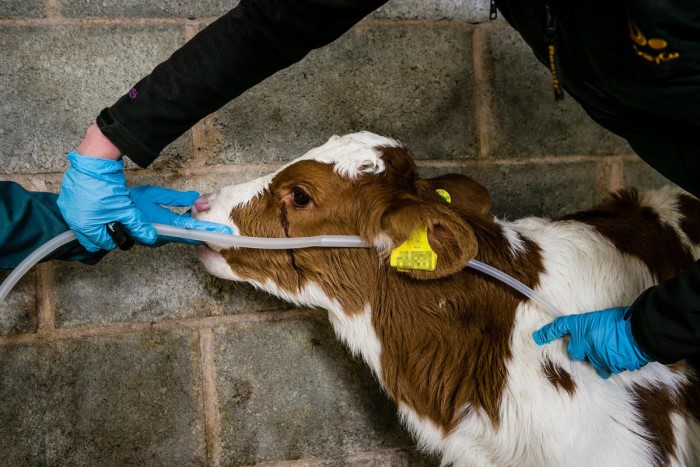- Home
- Knowledge library
- Tube-feeding colostrum to calves
Tube-feeding colostrum to calves
Caring for newborn calves properly is critical for long-term health and survival. If a calf can’t suck a bottle or drink the full amount of colostrum, then use a stomach tube.
How to tube feed a calf
Tube-feeding a calf is a skilled technique that requires training to be able to place the tube correctly. See how to tube-feed a calf using our Colostrum feeding video.
You will need:
- Feeding tube (plus a spare)
- At least 3 litres of colostrum, warmed to 38°C
Before feeding any colostrum to the calf, make sure all equipment has been thoroughly cleaned and is in good working order. Sharp edges or disintegrating rubber can harbour bacteria and may damage the calf’s mouth.
Inserting the tube
- Before inserting the tube into the calf’s mouth, moisten it with warm water or colostrum
- Holding the calf’s head in a natural position, slowly pass the tube over the tongue to the back of the mouth
- The tube should enter the oesophagus, which is directly above the windpipe
- Be extremely careful to ensure the tube enters the oesophagus and not the windpipe
- Stop immediately if you feel any resistance – pull the tube out slightly and redirect. The tube should never be forced
- When the tube is in the correct position, the calf should be comfortable and swallowing
Handling the calf
- An easy way to handle the standing calf is to back it into a corner with one hand under its muzzle to keep its head and neck in a natural position
- Work quietly and calmly to minimise stress to other animals in the pen
- If carrying out this task within the calving pen, be aware of the cow’s maternal instinct to protect her calf
- Before inserting the tube, ensure it is the right length for that individual calf. The tube should be measured from the tip of the calf’s nose to the point of the elbow behind the front leg, then mark this point on the tube, as shown below

Checking placement
The windpipe is a harder structure, with rings obvious to the touch, while the oesophagus is a softer, collapsible structure.
When the tube is in the correct position, it will inflate the oesophagus, meaning that both structures can be felt.
Avoid tubing calves that are lying down: milk can enter the lungs, which can cause death.

Feeding colostrum
When the calf is comfortable and you are happy with the tube’s position, colostrum can be introduced:
- Feed colostrum at body temperature of 38ºC
- Control the flow rate by raising and lowering the bag
- Keeping the bag low will be more comfortable for the calf
- Feed colostrum at a slow rate to minimise regurgitation
- Once this technique is mastered, it can also be used to give electrolyte fluid to dehydrated calves and older animals
Cleaning equipment
- Immediately after use, rinse the feeding tube, then thoroughly clean and disinfect it
- Hang the tube in a clean, dry environment so it can drain and dry
Useful links
Colostrum feeding
If you would like to order a hard copy of the Calf management guide, please contact publications@ahdb.org.uk or call 0247 799 0069.

